
 |
| A vintage Cartier Santos from the early 1900s. |
In 1987, the Santos was completely revised, renamed, and relaunched as the Santos Galbée. The case lost its boxy looks and became more curved around the lugs. Most Santos Galbée models were quartz-powered, though some models featured mechanical movements. The Santos Galbée was last updated in 2005 with the release of the Santos Galbée XL.
In 1998, Cartier introduced the Collection Privée Cartier Paris, which include two new Santos-Dumont models using a Frédéric Piguet movement. In 2004, Cartier launched the Santos 100 collection to commemorate the 100-year anniversary of Louis Cartier making a wristwatch for his friend Santos-Dumont. It is in this iteration that the concept of two sizes were introduced; the Large and the Medium sized casings. Cartier also added the chronograph complication in some of the models.
After more than a decade, in 2018, Cartier did another major update. A collection of watches in two sizes, medium and large was introduced. It also introduced some of its new patent-pending technologies. The first is the Cartier’s SmartLink System which allows you to take bracelet links out yourself without needing special tools or a visit a watchmaker to make the adjustment. On the back of the bracelet links, there’s a small button one can press that makes the pin holding the link in place to disengage. The second is the Cartier’s QuickSwitch System which makes is easy to swap the bracelet for one of its leather straps by just pushing a tab between the lugs, which then lets you slide the bracelet or strap out.
In 2023, the smoky green sunburst dial Santos De Cartier was introduced which is the focus of this review.
The Watch
The Santos De Cartier is made out of stainless steel with a semi-steampunk-ish square case with visible screws all over the surface of the casing and bracelet. Measuring 39.8 mm wide (excluding the crown) and a lug-to-lug length of 47.5 mm, this series of Santos De Cartier is defined as the 'large model' design. The designers was able to keep the thickness of the watch to just 9.38 mm even with an automatic movement. Despite the 'large model' classification by Cartier, the watch wears well even for my wrist which has a circumference of 6.75 inch.
It has that familiar and elegantly curvy, ergonomic shape which hugs the wrist nicely. This is a watch devoid of sharp edges, it's essentially a square watch that's curvy. It surfaces have alternating polished and satin-brushed finishes which, unfortunately, susceptible to scratches.
Due to the square nature of the watch dial, the chapter ring is straight walled and polished. The dial surface has that sunburst jade green that only obvious at certain viewing angle. Like magic, it can look black, charcoal grey, green or any shade in-between. Just beautiful, mysterious and mesmerizing. I was made to understand that the effect was made by manually applying a tinted layer of lacquer over the dial.
On the dial, there are three lines of text, two sets of timing scale and a date window. All the texts are painted white on on the dial with the brand name at the upper quadrant while the words 'AUTOMATIC' and 'SWISS MADE' located at the bottom quadrant. The hour marker are Roman numerals while the minute scale uses a train track design. There are areas on the minute scale painted with luminous paint that can double up as hour markers when it is darker. I note that this is the first watch is the collection that has the applied hour markers at the peripheral first and then the minute scale. All the watches in the collection has the opposite setup (minute markers first at the edge and then the hour markers). When Cartier designed the original Santos (with input from Mr. Alberto Santos-Dumont), the key focus of the watch is to track time to the correct minute or seconds. As an early aviator, timing was everything to ensure safety.
The hands on the Santos De Cartier are of a sword design with luminous paint provided on the hours and minutes hands. Otherwise, the non-painted surfaces are polished to a mirror finish. Meanwhile, the 6:00 hour marker was replaced with a date aperture, framed in white paint. The date wheel has a black background to minimize the disruption to the dial. To make it even more effective, Cartier could have considered a date wheel with the same green color background as the dial. Nevertheless, the dial is legible and clean.
Protecting the dial is a curved sapphire crystal. In following the shape of the watch casing, the curvature of the sapphire crystal from the center of the watch to both lugs in a horizontal plane instead of radial from the center for round watches. This has an interesting effect on the refractive effect when viewing the dial at certain angles. The crystal is place slightly higher than the fixed bezel. The crystal is beveled to reduce any sharpness. Nevertheless, this setup increases the likelihood of side impact damage.
The fixed bezel is highly polished. It appears to attached to the casing using eight screws, two on each side. For those of you with some form of OCD, a typical sample has random alignment of the screw tops. Frustrating, but I suspect it was done on purpose (I am sure they must have gotten a lot of complains on this over the years). Having it random implies that it is unique to that watch and it also gives an impression that the parts are only held together by screws. The same can also be seen on the case-back and the bracelet.
The crown, located at 3:00 has an adequate form of protection with protruding shoulder tabs from the casing covering at least 75% of the crown when pressed in. The crown has a faceted synthetic blue spinel typical of Cartier. As the watch has a green dial, it would be more appropriate to get a green spinel instead.
The case has a slight curve when viewing the side profile. It keeps the watch firmly flat on the wrist, brings extra comfort and ultimately makes it look more unified with the bracelet.

The links on the bracelet are straight and add to the angular look of the watch. Yet, each link is slightly domed making it tactile to the touch. There are screws found on every link which are a defining characteristic of Cartier. Each is polished and set into the stainless steel link but uniquely, the screws are not aligned (like the bezel). The bracelet also has a nice taper from the lugs to the butterfly clasp. 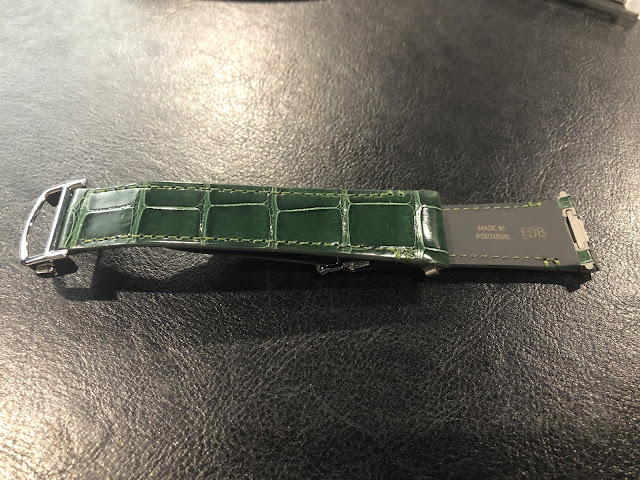
As part of the packaging, a green crocodile leather strap is also provided. Personally, a green cow leather would be more appropriate for this watch as the crocodile skin pattern distracts focus from the watch casing.

Cartier has incorporated some interesting technologies into the bracelet. Cartier developed the SmartLink and QuickSwitch systems, making the bracelet one of the most user-friendly on the market. SmartLink allows you to adjust the bracelet length without using any tools. There are small buttons on each link which can be pressed with almost anything, which releases the pin, allowing you to remove the link. Cartier developed the system so that the pin does not come all the way out, so there is also no concerns about losing anything. Although the bracelet does not have micro-adjustment point on the clasp, it is easy to add links if required. The QuickSwitch system is a similar concept. When you want to change the strap, there is a button found between the lugs that can be pushed to release the bracelet. A leather or rubber strap can be then clicked into place. Again, this is all achieved without using any tools and can be done in a matter of seconds.
The Purchasing Experience
Diameter: 39.8 mm
Dial Color: Green


















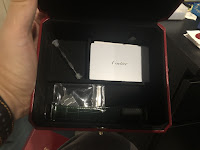



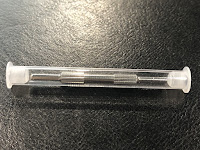
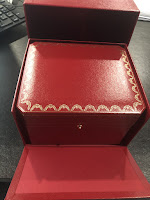
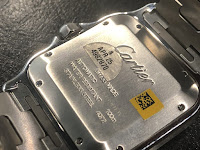







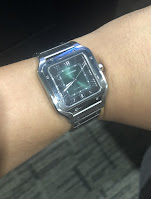





No comments:
Post a Comment